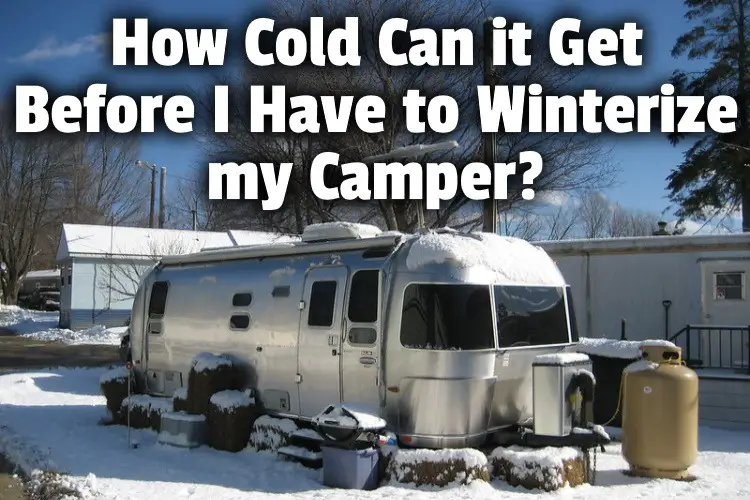The harshness of winter depends on where you are based. Luckily, most people with an RV can move around. But if you’re staying put in a cold climate, you may have asked how cold can it get before I have to winterize my camper?
You should winterize your camper or RV if the temperature drops to below 35 degrees during the day and below 30 degrees at night, especially if you won’t use it or have it powered.
In this article, we will look at how cold your pipes can get before they freeze.
After that, we will discuss whether or not you should winterize your camper. We will also discuss whether or not you can winterize without using antifreeze. We will discuss this and more, so, for everything you need to know, keep reading.

Will RV pipes freeze at 32 degrees?
If the water inside the RV pipes goes below 32 degrees Fahrenheit and the water is not flowing, the pipes can freeze. However, you can also wrap pipes with heat strip tape to help prevent freezing.
32 degrees Fahrenheit is the point at which water freezes.
If there is no water in the pipes, then no, the pipes should not freeze at 32 degrees. With that being said, if the temperature drops below 20 degrees Fahrenheit, your empty pipes might still freeze.
Most of the time, the outside temperature needs to be colder than 32 degrees Fahrenheit to freeze the water inside the pipes. This is because the temperature around and in the pipes will often be slightly warmer than the temperature outside.
You can also combat this by flushing your entire system, including your tanks, with a good antifreeze.
Some people have a misconception that antifreeze completely stops the freezing process. This is not true. It just makes it so that the temperature at which water freezes is lower than without the antifreeze.
Who enjoys winter camping? We have everything you need to may your caravan or motorhome as comfortable as possible. Take a look at our website @Outdoor_WorldUk #caravan #caravanaccessories #caravanninglife #motorhome #motorhomelife #outdoorworlduk pic.twitter.com/1tTj0ShB2i
— OutdoorWorld (@Outdoor_WorldUk) October 12, 2020
Do I need to winterize my pop-up camper?
You should winterize a pop-up camper if temperatures consistently get below freezing point and you don’t plan on using it. If you plan to use it, simply ensure you have adequate power, extra blankets, and heavy-duty curtains.
Because campers are far less insulated than motorhomes, using it will be really cold if you are in a cold climate. The steps to winterize it will be slightly different compared to just parking it.
Here’s what to do if you aren’t planning to use it:
- Drain all tanks
- Run all faucets and flush the toilet
- Use compressed air to flush all the water out of the pipes and tanks, 30 PSI max, connected to where you connect the hose at a campground)
- Pour antifreeze down every sink drain (and shower drain & toilet)
Of course, if you plan to live in the camper, you won’t drain the tanks or use antifreeze.
But just like in your home, drip the faucets when it’s below freezing. You’ll also want to do some or all of the following:
- Use heat tape or strips to wrap all exposed pipes outside the camper
- Consider adding rugs for added insulation
- Get heavy-duty curtains for the sides where the mesh netting is
- Use tarps to make a DIY cover to go over the mesh sides to block wind
- Keep the power on to help keep the unit warmer than the outside air
Storage space is almost gone! Give us a call at 204-594-9256 to reserve your winter spot today! #Storage #OutdoorStorage #HeadingleyStorage #RVLifestyle #Motorhome #Headingley #HeadingleyWestStorage #RVTravel pic.twitter.com/xRUOciigGa
— Headingley W Storage (@HWStorage) October 20, 2020
Can you winterize an RV without antifreeze?
To winterize your RV without antifreeze, simply drain all tanks, run all faucets, and flush the toilet. Then, hook a compressed air tank to the water inlet valve and blow air at 30 psi maximum to clear excess water. Then use heat tape on all exterior pipes.
Using antifreeze in your pipes and tanks is one of the most critical steps of winterizing your RV, especially when the temperature drops below 32 degrees Fahrenheit.
However, with that being said, you can winterize your RV without antifreeze.
Let’s take a look at the above steps in greater detail:
- Use compressed air to flush all the water out of your system before hooking up to a water outlet: This is an alternative. However, it is not the recommended method of preventing your pipes from freezing. Using compressed air on your pipes should be used as a method that prepares your pipe for antifreeze. If you are willing to flush your pipes regularly, antifreeze is not as necessary.
- Use electrical pipe and tank heaters: Using pipe and tank heaters is probably the best method. I will refrain from calling it an alternative because it is something that you should do whether you are using antifreeze or not. In the harshest of winter conditions, heaters are a necessity.
Of course, if you decide to add antifreeze, it’s a fairly simple process. If you won’t be using the RV and it won’t have power, ideally follow the above procedures and completely drain and flush all tanks.
Then to use antifreeze, here’s what to do:
- Pour about 32 oz down every drain the RV
- Pour 16 oz into the toilet and flush
Don’t just use regular automotive antifreeze though!
Here’s my favorite RV antifreeze on Amazon. Just click that link to check the current price on Amazon. Well over 100 near-perfect reviews and very low shipping considering how heavy it is.
Depending on the size of your camper, you’ll need 2-3 gallons minimally.
It’s important to keep the frost off the screen of your Motorhomes this winter. Also keeps the heat in too 👌🏼#keeptheheatin #motorhome #motorhomelife #frost #frostymorning #citroenmotorhome #fiatmotorhome #peuegotmotorhome pic.twitter.com/42pcz9eXjo
— OutdoorWorld (@Outdoor_WorldUk) January 11, 2021
Will RV holding tanks freeze?
RV holding tanks can freeze when water is present, and the outside temperature drops below 32 degrees Fahrenheit. However, this is unlikely unless the temperature is significantly below 32 degrees.
But there are so many variables that go into this question that it can be hard to answer.
The most notable variable is the location of your holding tanks. In severely cold temperatures, even if your tanks are in the warmest location of the RV, you might only be able to delay them from freezing.
That is why it is highly recommended that you install an aftermarket heating system on your tanks.
A specialized electric blanket for your holding tanks is probably your best bet as it requires the least amount of work, and it does the job.
Obviously, the blanket needs to be powered continuously, so that is something that you should also consider.
Installing this type of electric blanket is relatively simple.
You just place it on top of whatever tanks you are trying to prevent from freezing. With all of that said, this can save you a lot of time, and it can end up saving you a lot of money, too.
I love this set of tank heater blankets from Amazon! They are fairly inexpensive, and it comes as a set of 3 for fresh, grey, and black water.
The best part is they kick on automatically when the temp drops below 45° F(5° C). And they simply connect to the nearest 12v power source; so they’ll work off battery, generator, or shore power. Almost all reviews are 5-star too!
If your tanks freeze and crack, it can cause a significant amount of damage.
Is winterizing an RV necessary?
If your RV is parked in a location without being used or without power and the temperature would frequently drop below 32 degrees Fahrenheit, it is recommended to winterize the RV.
With that being said, if you are going to stay somewhere like Florida, it might be pointless to do so.
If you don’t winterize your RV, you can turn what should have been a pleasant winter into an expensive nightmare. There’s so much that can go wrong, especially with your plumbing system.
I will also point out though that where I live in Central Texas there are probably lots of people that don’t winterize.
I did this year as we had a freak snowstorm and the temps dropped much lower than normal (single digits). But there were plenty of times before that where temps were in the high 20’s and 30’s and the RV was fine with no winterizing.
Conclusion
I have written a recent article that goes a lot more in-depth about winterizing a motorhome but living in it at the same time.
I highly recommend giving that a good read. Just click that link to read it on my site.
So use your judgment. Whatever you do to your house is probably what you want to do to your RV. Minimally, that’s dripping faucets and maybe setting the heater to come on at 65° F if you just have it parked.
And if it’s parked and empty without power, it’s worth draining all the tanks first (including flushing the toilet) and using compressed air to blow through the drains. And if temps get well below 32° F (0° C) antifreeze, tank heater blankets, and thermal tape for your pipes are all good options.
But once spring rolls around, it’s time to de-winterize your RV!
Check out my complete step-by-step guide and checklist on de-winterization. I show you everything you need to do to get your RV ready be back in action.
Just click that link to read it on my site.
Photo which requires attribution:
IMG_7468 by Matthew Simoneau is licensed under CC2.0 and has been cropped with a text overlay added
Middle Class Dad is a participant in the Amazon Services LLC Associates Program, an affiliate advertising program designed to provide a means for sites to earn advertising fees by advertising and linking to Amazon.com. As an Amazon Associate, I may earn a small commission from qualifying purchases if you click to Amazon from my site and choose to make a purchase. This is no way increases the cost to you.
